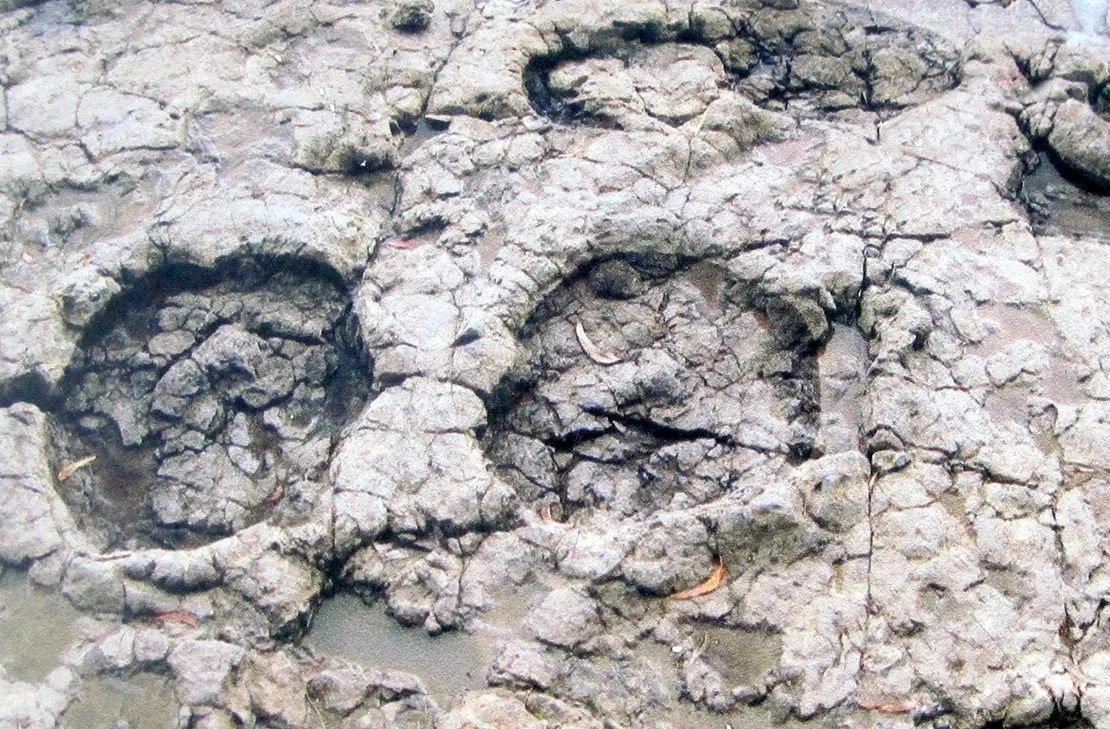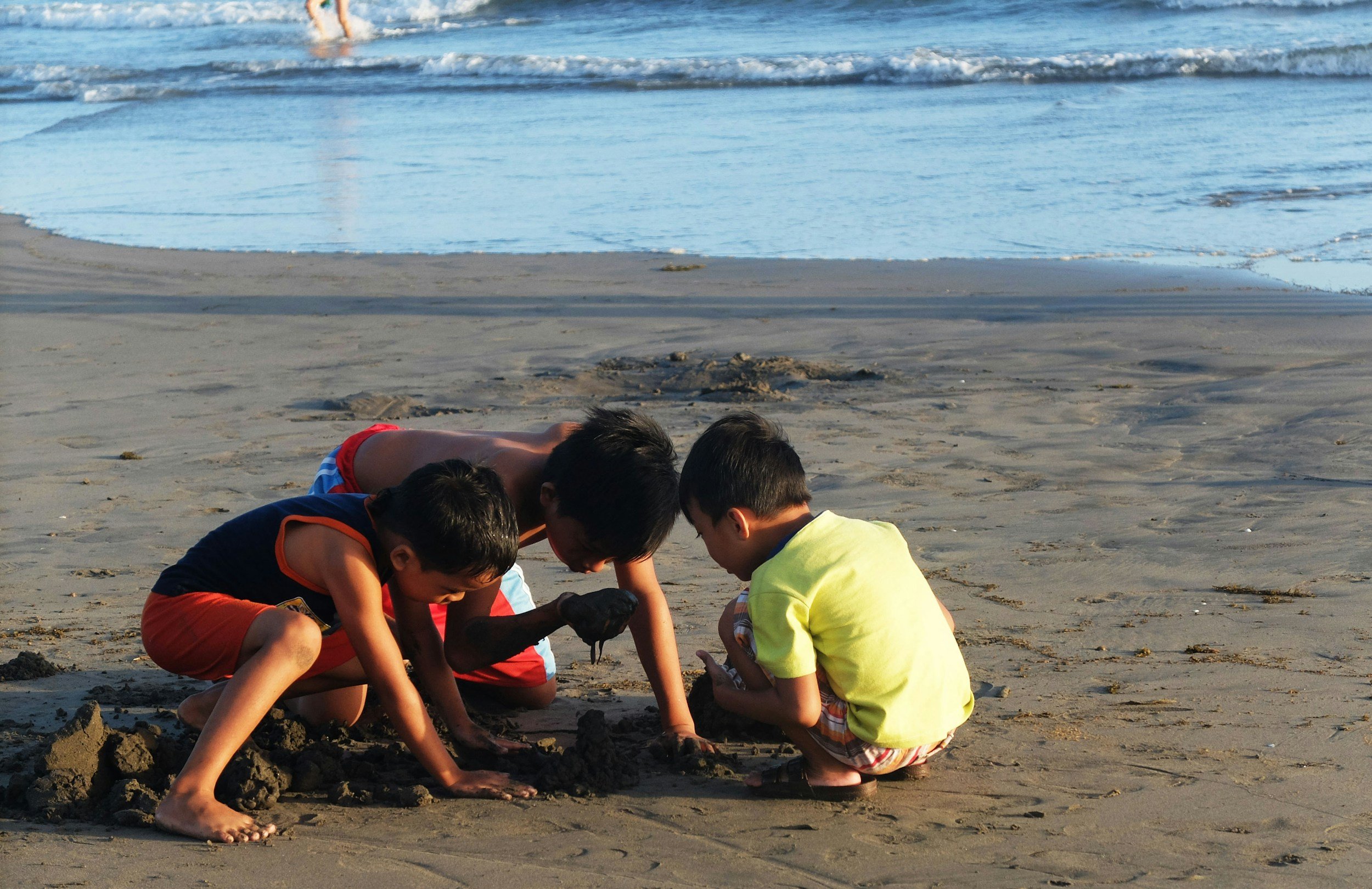La Griega Dinosaur Footprints - Walking with Giants on Asturias' Jurassic Coast
🔗 Real Stories, Local Secrets, and Slow Travel in Northern Spain.
FLAVOUR TRAILS | SOUL OF THE NORTH | WILD ASTURIAS | FAMILY EXPLORERS | PROPERTY PULSE | ALL
Walking in the Footsteps of Giants
Standing on the rocky shore at Playa de la Griega, watching Alba trace 150-million-year-old dinosaur footprints with her finger, I'm struck by the incredible privilege of this moment. These aren't replicas in a museum or casts behind glass - they're actual traces left by massive creatures that walked this landscape when it was a warm, tropical shoreline during the Jurassic period.
What makes La Griega extraordinary isn't just the age of these footprints, but their accessibility. At low tide, you can walk directly onto the rocky platform where time has preserved these ancient stories. The MUJA Jurassic Museum perched on the cliffs above provides the scientific context, but down here on the beach, you're experiencing paleontology as discovery rather than display.
Alba's fascination with these footprints goes beyond typical childhood dinosaur enthusiasm - there's something profound about touching the same rock surface that these creatures pressed into millions of years ago. It connects us to deep time in a way that makes the vastness of geological history suddenly tangible and personal.
The Trail Experience
Route Options to La Griega
Option 1: Via PR-AS 196 Coastal Route (Most Popular) If you're following our PR-AS 196 Ruta de los Misterios del Mar guide, La Griega is your spectacular destination! The coastal path from La Isla brings you directly to the beach where the dinosaur footprints await. This is the most scenic approach and combines clifftop walking with paleontological discovery.
For PR-AS 196 Walkers: Plan extra time at La Griega for footprint exploration - allow 45-60 minutes minimum on the rocky shore if tides are favorable. Check tide times before starting your walk from La Isla to ensure optimal viewing conditions when you arrive.
Option 2: Direct Access from La Griega Park directly at Playa de la Griega for immediate access to the dinosaur site, ideal for families with young children or those primarily interested in paleontology rather than coastal walking.
Option 3: PR-AS 134 "Ruta entre Playas" Connect from Huerres village via the inland PR-AS 134 trail through San Juan de Duz - this 3km route focuses on the countryside approach to the beach.
Extending Your PR-AS 196 Walk
If You're Coming from the Coastal Route: Arriving at La Griega after the spectacular clifftop walk from La Isla feels like the perfect reward - you've earned this incredible paleontological discovery through beautiful coastal walking. The transition from elevated marine terraces to the rocky shore platform creates a natural geological narrative.
Timing Considerations for Coastal Walkers:
Start early from La Isla if low tide is in the afternoon
Check tide tables before beginning your coastal walk - there's nothing more frustrating than arriving at La Griega during high tide
Pack extra water and snacks - you'll want to spend substantial time exploring the footprints
Allow 3-4 hours total for the complete experience including footprint exploration
Continuing the Loop: After exploring the dinosaur site, the PR-AS 196 route continues via the inland return through San Juan de Duz and Huerres villages. This creates perfect variety - coastal drama, paleontological discovery, and traditional rural Asturias all in one walk.
Exploring the Footprint Site
Understanding the Geology: The dinosaur tracks are preserved in what geologists call "icnitas" - trace fossils that show behavior rather than the creatures themselves. These particular prints were made in soft sediment that later hardified into rock, preserving the impressions for 150 million years.
What You'll See: The site contains multiple trackways showing different species and sizes of dinosaurs. Some prints are clearly defined individual footprints, while others form clear pathways showing the animals' movement patterns across this ancient landscape.
The Tidal Factor: Low tide is essential for optimal viewing. As the water recedes, it reveals more of the rocky platform and cleans the footprints of accumulated sand and seaweed. The contrast between wet and dry rock also makes the depressions more visible.
Reading the Ancient Landscape
What strikes me most about spending time at La Griega is how it changes your perspective on the entire Asturian coast. Suddenly, every rocky shore and elevated terrace becomes part of a vast geological story. The Sierra del Sueve rising behind you, the marine terraces you've walked, and these ancient footprints all connect into a narrative spanning millions of years.
Alba has learned to spot the difference between natural rock formations and actual footprints - the way the edges are too regular, the depth too consistent, the spacing too purposeful to be anything but biological. It's become a game for her, and she's surprisingly good at identifying the clearest examples.
What to Pack
Essential Gear
Tide tables - Absolutely crucial for timing your visit
Non-slip footwear - The rocky platform can be slippery when wet
Camera with good close-up capability - Document your discoveries
Small backpack - Keep hands free for scrambling on rocks
Water and snacks - Limited facilities at the beach
Recommended Extras
Magnifying glass - Alba loves examining the footprint details closely
Notebook and pencil - Sketch what you see or take notes about different trackways
Plastic bags - Protect electronics from sea spray
Towel - Useful for cleaning hands after touching rocks
Binoculars - Spot footprints from a distance before walking to them
Family Considerations
Extra clothing - Children will get wet and muddy exploring
First aid basics - Rocky shores require careful movement
Sun protection - Limited shade on the beach platform
Essential Information
Access and Timing
Location: Playa de la Griega, Colunga municipality
Parking: Limited spaces at beach access road end
Tide Dependency: Low tide essential (check Spanish tide tables)
Best Viewing: 2-3 hours either side of low tide
GPS Coordinates: 43.4847°N, 5.2897°W
Route Specifications
Direct Access Route:
Distance: 500m from parking to footprint site
Difficulty: Easy to moderate (rocky shore walking)
Time: 1-2 hours at the site
Surface: Rocky shore platform, can be slippery
Via PR-AS 196 (Full Loop):
Distance: 7.6km complete loop including footprint site
Difficulty: Moderate - there are some steep parts
Time: 3-4 hours total
Combination: Coastal walking + paleontology + village culture
Getting There
From Oviedo: 50 minutes via A-8, exit 337 Colunga, follow signs to La Griega
From Gijón: 45 minutes via A-8, same exit
From La Isla: 15 minutes by car, or via PR-AS 196 coastal walk
Public Transport: Limited ALSA service to Colunga, then taxi or walk
Safety Considerations
Rocky shore can be slippery when wet
Always check tide times before visiting
Keep children close - waves can be unpredictable
Weather changes quickly on exposed coastline
What Makes It Special
The Paleontological Significance
La Griega represents one of Europe's most accessible and well-preserved dinosaur trackway sites. Unlike museum displays, these footprints remain in their original geological context, allowing visitors to experience paleontology as field science rather than static exhibition.
The diversity of tracks suggests this was an important corridor for dinosaur movement during the Jurassic period, when this area was a warm coastal plain rather than the temperate maritime landscape we see today.
Connection to Deep Time
Standing where these creatures walked creates an almost vertiginous sense of time. The footprints connect us directly to the Mesozoic Era, when the supercontinent Pangaea was breaking apart and the Atlantic Ocean was just beginning to form.
Scientific Accessibility
The site democratizes paleontology in a way few locations can. You don't need special permission or scientific training to examine these traces - just patience, curiosity, and respect for the site's preservation.
Integration with Landscape
The footprints aren't isolated artifacts - they're part of a larger geological story that includes the coastal terraces, the nearby MUJA museum, and the broader Dinosaur Coast designation that recognizes this region's paleontological importance.
After Your Discovery
Document Your Visit
Take photos of the clearest footprints, but also capture the broader context - the relationship between the tracks and the surrounding landscape helps tell the story of ancient environmental conditions.
Alba has started keeping a nature journal where she sketches the different footprint shapes and tries to imagine the creatures that made them. It's become a way of processing the enormity of geological time through a child's perspective.
Connect to MUJA Museum
The Museo del Jurásico de Asturias provides essential context for what you've just experienced. The museum's exhibits about Jurassic Asturias help you understand the ancient climate and ecosystem that produced these tracks.
From the museum's clifftop location, you can look back down at the beach where you've just been exploring, creating a perfect connection between field experience and scientific interpretation.
Explore the Broader Dinosaur Coast
La Griega is just one site in a broader network of paleontological locations along the eastern Asturian coast. Tazones and other coastal villages also preserve dinosaur traces, making it possible to create multi-day paleontological tours.
Traditional Asturian Recovery
After hours of rocky shore exploration, nearby Lastres offers the perfect combination of traditional architecture and excellent seafood. Casa Eutimio and El Barrigón de Bertín serve fresh local catch that connects you to the contemporary marine life that inhabits these same waters.
There's something perfect about following a morning of deep time exploration with an afternoon of traditional Asturian culture - it grounds the vast geological perspective in the human-scale pleasures of excellent food and beautiful village architecture.
Planning Your Visit
Ideal Combinations
Coastal Walker Special: PR-AS 196 loop + extended La Griega exploration + traditional lunch in Lastres
Half Day Focus: Direct La Griega access + MUJA museum + village exploration
Full Day Adventure: Complete PR-AS 196 loop + MUJA museum + Lastres cultural tour
Family Discovery: Coastal walk to La Griega + beach picnic + short village return
Tide Planning
Check tide tables at least a day in advance and plan your entire day around optimal low tide timing. The 2-3 hour window either side of low tide is crucial for access to the best footprint locations.
Weather Considerations
Clear Days: Best for photography and detailed footprint examination
Overcast: Often provides better contrast for seeing footprint details
Rainy Weather: Avoid - slippery rocks become dangerous
Windy Conditions: Can make rocky shore walking challenging
Seasonal Variations
Spring: Excellent conditions, fewer visitors, wildflowers in surrounding areas
Summer: Peak season with most facilities open, but crowds increase
Autumn: Often the best weather for coastal walking and clearest views
Winter: Dramatic storm watching opportunities, but challenging beach access
Extended Explorations
The PR-AS 134 "Ruta entre Playas" connects La Griega with other coastal sites, making it possible to create longer walking itineraries that combine multiple paleontological locations with traditional coastal villages.
La Greiga looking towards Lastres
La Griega offers that rare combination of scientific significance and natural beauty that makes learning feel like adventure. Whether you're following the complete coastal route or making a focused visit to the footprint site, you're connecting with one of the most remarkable paleontological treasures in Europe - one that remains accessible, authentic, and deeply integrated into the spectacular landscape of the Asturian coast.
La Griega offers that rare combination of scientific significance and natural beauty that makes learning feel like adventure. Whether you're following the complete coastal route or making a focused visit to the footprint site, you're connecting with one of the most remarkable paleontological treasures in Europe - one that remains accessible, authentic, and deeply integrated into the spectacular landscape of the Asturian coast.
Related Jurassic Adventures
Previous in Series:
PR-AS 196 Ruta de los Misterios del Mar - Complete Walking Guide - The coastal route to La Griega
Next in Series:
La Espasa to Arenal de Morís - Family Coastal Walk - Perfect for children after dinosaur discoveries
Cultural Connections:
MUJA Museum: Journey Through Jurassic Asturias - Essential scientific context
Lastres: Village Life on the Dinosaur Coast - Perfect post-exploration destination
Colunga Thursday Market: Traditional Shopping on the Dinosaur Coast - Local culture and logistics




